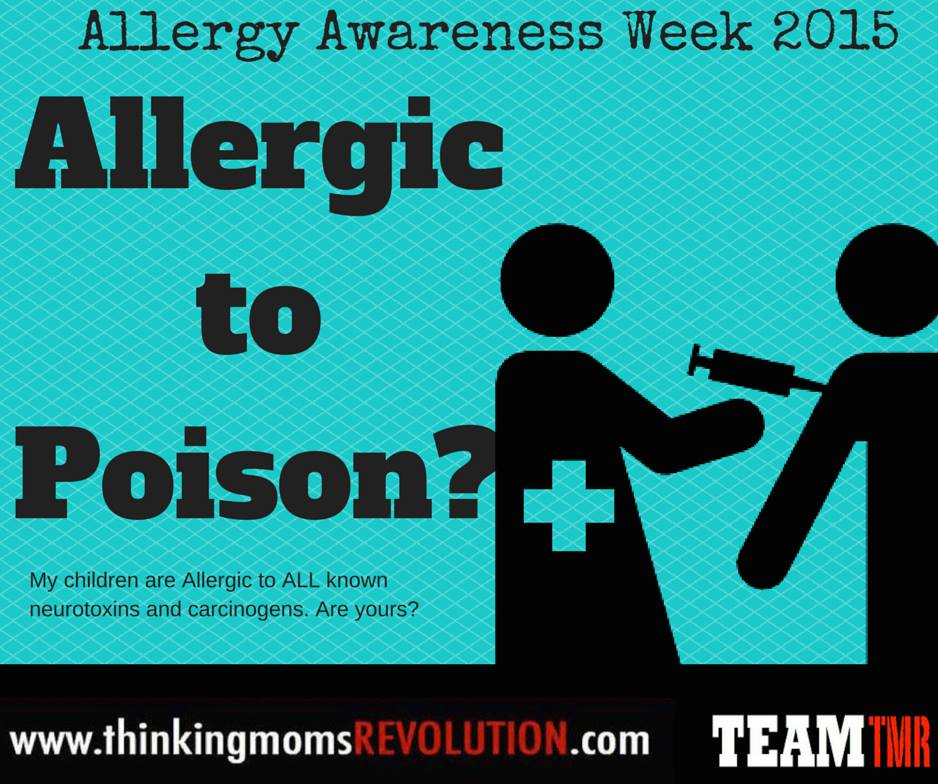So this week is light it up TEAL week for allergy awareness. I know many who had their fill of all things BLUE in April, so having another shade of it in May seems appropriate!
Allergies are serious stuff, from peanuts to pollen and from shellfish to stings (bee), they are no laughing matter. But one thing that strikes me about this awareness week and many people in the allergy community at large is that few are asking why? Why do schools need peanut-free tables, when none existed 30 years ago? Why have the numbers skyrocketed?
Being a part of so many different disease communities because of our child’s healing journey, I’ve observed things that are troubling to me across all conditions. One of those things is how all these sick children react to and handle toxins, a.k.a. poison, or at least what the body has determined is a poison.
So I got to thinking . . . How is allergy testing done? The old-fashioned way is to prick the skin and introduce a small amount of a substance to the body to see if a “wheal” appears (a.k.a. “hive”). If one appears, then the size of the spot determines how allergic the person is to the substance. This is called the skin-prick test.
Sooo . . . how many infants, children, teens, and even adults have tested for allergy to poisons? That is absurd, you may be thinking. Who would ever allow a doctor to pierce your newborn’s skin with a needle, introduce a poison and see if a hive appears? Preposterous! Are you crazy?
Well, isn’t that what we “allow” every time we take a baby in for a well-check and a round of vaccines? Have you had your children tested to see if they are allergic to aluminum, Thimerosal, formaldehyde, monosodium glutamate (MSG), aborted fetal cells, ethanol, phenol, detergent or anything else listed on this vaccine ingredient list? Well, one way to tell is to pierce the skin and introduce a bit of it to the body to see what happens. Did a big red lump form? Did your child break out in a rash or hives, or worse? You were probably told these were normal reactions . . . or were they? Perhaps this was the body’s way of saying, just like in skin-prick allergy testing, that this child is allergic to the poison at the tip of the needle.
As my good friend says, “My children are allergic to ALL known neurotoxins and carcinogens.” Are yours?
Happy Allergy Awareness Week.
We all need more awareness, especially about WHAT is causing this allergy epidemic. Could it be the poison at the tip of all those needles?
~ Beaker
For more by Beaker, click here.



















Specialized Kinesiology is another way; safe and more subtle as to why the allergy, and the where of the allergy. In the old days testing was done by putting a food under the tongue and then muscle testing. This could still set off a huge reaction. As a result we were re-trained to put the food on the skin over the (cheek) parotid area. I have often wondered since peanuts are full of aflatoxin if the allergic reaction is to the food or a reaction to the toxic mould/fungus. Once this is wired into the body’s phobia zone, would peanuts free of aflatoxin set off the same response. Just a theory.
“Specialized” or “Applied” Kinesiology is a total scam – stay away from any practitioner who offers it! It has never passed a blinded test.
And, yet, like so may things, it has yielded good results for many people. We are not quick to label useful techniques “scams,” even if they cannot be performed identically every time in a laboratory.
Actually, doctors at the FDA/CDC have admitted that food proteins in vaccines can cause food allergy.
Nobel Laureate Charles Richet discovered over a hundred years ago that
injecting proteins into mammals can cause them to develop an allergy to
that protein.
In 2002, the doctors from the CDC and FDA warned that gelatin-containing
vaccines can cause gelatin allergy based on similar findings in Japan.
“Nonetheless, our cases with anti-gelatin IgE required some previous
exposure to gelatin to become sensitized, and this may have come through
ingestion of gelatin-containing food or injection of gelatin-containing
vaccines.”
They wrote: “Efforts should continue to identify less allergenic
substitutes for gelatin currently used by vaccine manufacturers.”.
Authors:
Vitali Pool, MD, CDC, M. Miles Braun, MD, MPH, FDA, John M. Kelso, MD,
Naval Medical Center, Gina Mootrey, DO, MPH, CDC, Robert T. Chen, MD,
MA, CDC, John W. Yunginger, MD, Robert M. Jacobson, MD, Mayo Clinic,
Paul M. Gargiullo, PhD, CD.
Prevalence of Anti-Gelatin IgE Antibodies in People With Anaphylaxis
After Measles-Mumps-Rubella Vaccine in the United States
http://pediatrics.aappublications.org/content/110/6/e71.long
Yet today, the CDC table here lists numerous food proteins contained in
vaccines, including gelatin, egg, milk, soy, seaweed and vegetable oils
(in Polysorbate 80, sorbitol).
http://www.cdc.gov/vaccines/pubs/pinkbook/downloads/appendices/B/excipient-table-2.pdf
The result – the food allergy epidemic.
And gelatin in vaccines is still making kids sick today:
http://acaai.org/resources/connect/ask-allergist/Vaccines
And how do they make all those lab rats anaphylactic so they can experiment on them with all those exciting treatments like peanut patches and OIT? Brand new, published study–injecting rats with alum, pertussis, and egg worked more efficiently and rapidly than any other method to make rats anaphylactic. It also increased intestinal permeability. Read, enjoy, draw your own conclusions: http://journals.plos.org/plosone/article?id=10.1371%2Fjournal.pone.0125314
Great Post Beaker! Abby is definitely allergic to poison! 🙂